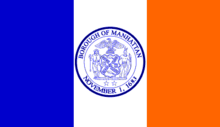Edgar J. Nathan
Edgar J. Nathan (August 28, 1891 – April 30, 1965) was a New York City attorney and political figure who served as Manhattan Borough President from 1942 to 1946. He is to date the last Republican to serve as Manhattan Borough President.
Biography
Edgar Joshua Nathan Jr. was born in New York, New York on August 28, 1891.[1][2] He graduated from Williams College in 1913[3] and Columbia University Law School in 1916[4] From 1916 to 1941 he practiced law in New York City at the firm of Cardozo and Nathan, which included several relatives, including his cousin Benjamin N. Cardozo.[5]
During World War I Nathan worked in Washington, D.C. as an attorney for the War Trade Board.[6]
A Republican, in 1937 Nathan was elected as a Delegate to the New York State Constitutional Convention, achieving success at the polls despite running in a Democratic district.[7][8] In 1938 he was an unsuccessful candidate for the New York Supreme Court.[9]
In 1942 Nathan won election as Manhattan Borough President, and he served until 1946. During World War II Nathan was involved in the city's civil defense effort and was a leader of bond drives, metal salvage events and other activities.[10][11][12][13]
After leaving office Nathan returned to the practice of law briefly as a partner in Gale, Bernays, Falk, Eisner & Nathan. In 1946 Governor of New York Thomas E. Dewey appointed Nathan to the New York State Supreme Court.[14][15] Nathan won election to a full fourteen-year term later that year, and was reelected in 1960.[16] The State Judicial Conference certified Nathan for continued service after he reached the mandatory retirement age for judges of 70, and he remained on the bench until his death.[17]
Nathan died in New York City on April 30, 1965.[18] He was buried in Congregation Shearith Israel's Beth Olam Cemetery in Ridgewood, Queens.[19]
Family
Nathan was descended from Abraham de Lucena, one of the first 13 Jewish immigrants to the United States. In addition, his ancestors included Rabbi Gershom Mendes Seixas, who founded New York City's Shearith Israel congregation in 1654.[20] Nathan was President of Shearith Israel from 1951 until his death.[21][22]
Another Nathan ancestor from his Seixas line, Benjamin M. Seixas, served as an officer of the New York Militia during the American Revolution. As a result, Nathan was able to join the Sons of the American Revolution.[23]
In addition to being related to Benjamin Cardozo, Nathan was also a cousin of Emma Lazarus.[24]
References
- U.S., World War I Draft Registration Cards, 1917-1918, entry for Edgar J. Nathan, Jr., accessed August 11, 2012
- U.S. World War II Draft Registration Cards, 1942 entry for Edgar J Nathan Jr., accessed August 11, 2012
- Williams College, Annual Bulletin, 1913, page 89
- Columbia University Alumni Council, Columbia Alumni News, Volume 31, 1939, pages 10, 29, 36
- New York Times, Nathan a Veteran in City Politics; Republican Designee for the Borough Presidency Also Close Friend of Isaacs, August 5, 1941
- U.S. Civil Service Commission, Annual Report, 1918, page 145
- New York Times, Nathan, Prominent Lawyer: Partner in Firm Once Headed by Cardozo, His Cousin, November 5, 1941
- New York Times, Republicans get grip on Convention, November 4, 1937
- New York Times, Desmond Plan Backed: Nathan Favors Handling of Bench Removals by Court, October 24, 1939
- New York Times, Scrapping Canopies Proposed by Nathan, October 5, 1942
- New York Times, War Course for Nathan Aides, January 15, 1942
- New York Times, Money From Scrap to Aid City Defense, October 5, 1942
- New York Times, Gold Star Mothers Will Convene Here, June 7, 1942
- New York Times, Nathan Nominated to Succeed Collins; Named to State Court, March 15, 1946
- New York Times, Justice Nathan Inducted: Supreme Court Ceremony Attended by Wife and Two Sons, March 26, 1946
- New York Times, Two Parties Pick Court Nominees, September 15, 1960
- New York Times, Edgar Nathan Jr., Justice, Dies at 73, May 1, 1965
- Social Security Death Index, accessed August 11, 2012
- Find A Grave
- Golden Book Foundation of America, American Jews: their lives and achievements ; a contemporary biographical record, Volume 1, 1947, page 340
- New York Times, Church Gives Goblet to Jewish Body Here, October 5, 1953
- New York Times, Synagogue Will Honor Justice E.J. Nathan Jr., January 20, 1962
- Sons of the American Revolution Membership Applications, 1889-1970, entry for Edgar J. Nathan, Jr., accessed August 11, 2012
- Morning Freiheit Association, Jewish Currents, Volume 30, 1976, page 9
External links
| Political offices | ||
|---|---|---|
| Preceded by Stanley M. Isaacs |
Borough President of Manhattan 1942–1946 |
Succeeded by Hugo Rogers |
